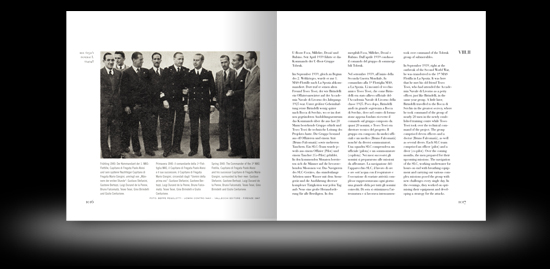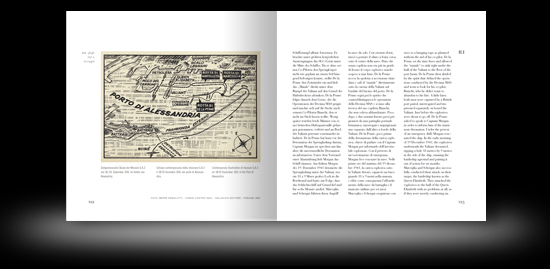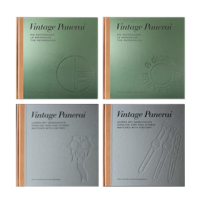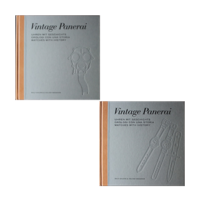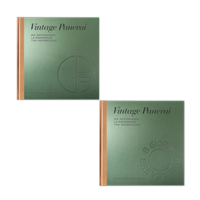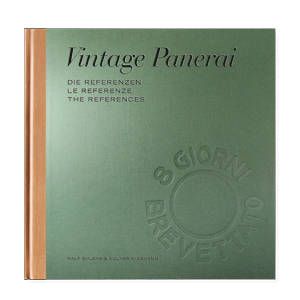Tag: 696
Naval heritage – Luigi Durand de la Penne
by Volker on Dec.25, 2023, under Allgemein
 Luigi Durand de la Penne was one of the famous SLC pilots of the Mezzi d’Assalto who wrote naval history in the Second World War. Luigi Durand de la Penne was born in Genoa, where he also died (11 February 1914 – 17 January 1992). He graduated from the Naval Academy in Livorno in 1934. He was one of the first crewmen of the 1° Gruppo Sommergibili who realized Teseo Tesei’s and Elios Toschi’s idea of a new, secret weapon in La Spezia: The SLC. At the training base Bocca di Serchio he was a member of the legendary group which founded the famous „Spirito del Serchio“.
Luigi Durand de la Penne was one of the famous SLC pilots of the Mezzi d’Assalto who wrote naval history in the Second World War. Luigi Durand de la Penne was born in Genoa, where he also died (11 February 1914 – 17 January 1992). He graduated from the Naval Academy in Livorno in 1934. He was one of the first crewmen of the 1° Gruppo Sommergibili who realized Teseo Tesei’s and Elios Toschi’s idea of a new, secret weapon in La Spezia: The SLC. At the training base Bocca di Serchio he was a member of the legendary group which founded the famous „Spirito del Serchio“.
The first remarkable milestones of his naval career was the rescue action of the transport submarine for SLC devices, the Iride: On 22 August 1940, in the Gulf of Bomba, the Iride was sunk by a torpedo released by a British Swordfish bomber. The air attack happened during an exercise, in shallow water, when four SLC teams were around, including the officers Teseo Tesei, Gino Birindelli and Luigi Durand de la Penne. They started an immediate rescue action. Of the 12 Iride crewmen who survived, two died during an unsuccessful attempt to surface, nine were retrieved alive (two of them died soon, due to wounds), and one was too shocked to leave the sunken submarine. Luigi Durand de la Penne tried to persuade him to surface, and even gave him his own rebreather, but the seaman refused surfacing and died.
Page 1016 – 1017: “Uomini della prima ora” – spring 1940 – before the mission G.A.1 failed dramatically. Luigi Durand de la Penne (3rd from left) together with the commanders of the 1st MAS Flotilla (Aloisi and Giorgini), surrounded by Stefanini, Bertozzi, Falcomatà, Tesei, Birindelli and Centurione.
The second milestone in Luigi Durand de la Penne’s naval career was the sinking of the British battleship Valiant. In December 1941, he was one of the “fab six” (Emilio Bianchi, his co-pilot; Antonio Marceglia with Spartaco Schergat and Vincenzo Martellotta with Mario Marino) that attacked the Port of Alexandria. As a result, four ships were disabled: the British battleships HMS Queen Elizabeth and HMS Valiant, the oil tanker Sagona and the destroyer HMS Jervis. Luigi Durand de la Penne was awarded the M.O.V.M. (the Italian highest military decoration awarded for valour “in the face of the enemy”). At the end of the war, Admiral Charles Morgan (the Valiant’s Captain at the time of the attack in Alexandria) wanted to confer himself the medal to Luigi Durand de la Penne in a ceremony in Taranto.
Page 122 – 123: Illustration of the mission G.A.3 on 18/19 December 1941 in the Port of Alexandria.
After 8 September 1943, Luigi Durand de la Penne was offered the opportunity to be released from prison and fight for the Allies. He accepted and returned to duty as a frogman. In June 1944, he participated in a joint Italian/British operation against the Germans (mission QWZ). A team of British and Italian divers sank the cruisers Gorizia and Bolzano before they could be used to block the harbour entrance. After the Second World War, Luigi Durand de la Penne stayed in the Marina Militare. He was promoted to Capitano di Fregata in 1950 and Capitano di Vascello in 1954. In 1956 he was appointed as Naval Attaché in Brazil.
Luigi Durand de la Penne‘s family donated decorations he was awarded during his career, and his Panerai watch to the museum at the COMSUBIN headquarters in Varignano / La Spezia. The Panerai watch, a Ref. 3646 / Type C with “Radiomir Panerai” dial has been recorded in our database in 2015. Enjoy reading more: Luigi Durand de la Penne M.O.V.M. is featured in chapter I (page 35), chapter II.I (page 94-123) and VIII.II (page 1016-1034) of our two “The References” books.
18 December 1941 – today in history…
by Volker on Dec.18, 2023, under Allgemein
After the failed missions in August and September 1940, the Decima MAS returned to the eastern Mediterranean in order to make another attemp to attack the Harbour of Alexandria with SLC devices of the Mezzi d’Assalto: “Operazione G.A.3”, carried out by Tenente di Vascello Luigi Durand de la Penne and Capo Palombaro I Emilio Bianchi (SLC 221), Capitano Genio Navale Antonio Marceglia and Sottocapo Palombaro Spartaco Schergat (SLC 222), Capitano Armi Navale Vincenzo Martellotta and Sottocapo Palombaro Mario Marino (SLC 223).
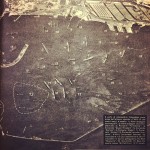 What turned out to be one of the most famous SLC missions in the Second World War has been announced in the Italian War Bulletin N. 585 of the 8th of January 1942: “On the night of the 18th December assault craft of the Italian Royal Navy entered the Harbour of Alexandria and attacked two British battleships anchored there. It has only just been confirmed that a battleship of the Valiant class was seriously damaged and put into dock for repairs, and is still there.”
What turned out to be one of the most famous SLC missions in the Second World War has been announced in the Italian War Bulletin N. 585 of the 8th of January 1942: “On the night of the 18th December assault craft of the Italian Royal Navy entered the Harbour of Alexandria and attacked two British battleships anchored there. It has only just been confirmed that a battleship of the Valiant class was seriously damaged and put into dock for repairs, and is still there.”
Bulletin N. 586 of the 9th of January 1942, added the following: “In the Operation conducted by assault craft fo the Royal Italian Navy in the Harbour of Alexandria and reported in yesterday’s Bulletin we now have definite further intelligence that, in Addition to the Valiant, a second battleship of the Barham class was also damaged.”
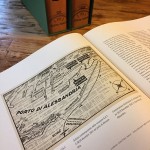 Winston Churchill announced in a speech before a secret session of the House of Commons on the 23rd of April 1942: “A further sinister stroke was to come. On the early morning of December 19 half a dozen Italians in unusual diving suits were captured floundering about in the Harbour of Alexandria… Four hours later explosions occurred in the bottoms of the Valiant and the Queen Elizabeth, produced by limpet bombs fixed with extra-ordinary courage and ingenuity, the effect which was to blow large holes in the bottoms of both ships and to flood several compartments, thus putting them both out of Actions for many months…”
Winston Churchill announced in a speech before a secret session of the House of Commons on the 23rd of April 1942: “A further sinister stroke was to come. On the early morning of December 19 half a dozen Italians in unusual diving suits were captured floundering about in the Harbour of Alexandria… Four hours later explosions occurred in the bottoms of the Valiant and the Queen Elizabeth, produced by limpet bombs fixed with extra-ordinary courage and ingenuity, the effect which was to blow large holes in the bottoms of both ships and to flood several compartments, thus putting them both out of Actions for many months…”
Read chapter II.I of our book “The References” 1930’s-1940’s to find out what happened on 18 December 1941 (page 118-125). More on the historic content in our “The References” book set with a total of 1392 pages can be found here and here. You can purchase “The References” 1930’s-1940’s in our bookstore. Enjoy reading!
“Il cavallo di Troia” – the secret SLC base
by Volker on Nov.23, 2023, under Allgemein
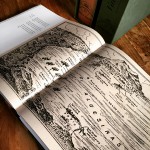 Enemy ships in the harbour of Gibraltar have been in the sight of the Royal Italian Navy since September 1940. After several attacks by “Gamma” frogmen and SLC units, ideas to build a secret base of the Decima MAS were realized in the second half of the year 1942. Convoy ships for the United States were beginning to arrive in quantity. The numbers of potential targets at anchor in the Bay of Algeciras were growing almost daily.
Enemy ships in the harbour of Gibraltar have been in the sight of the Royal Italian Navy since September 1940. After several attacks by “Gamma” frogmen and SLC units, ideas to build a secret base of the Decima MAS were realized in the second half of the year 1942. Convoy ships for the United States were beginning to arrive in quantity. The numbers of potential targets at anchor in the Bay of Algeciras were growing almost daily.
Earlier in 1942, a base for the Decima MAS “Gamma” frogmen was established in the Villa Carmela near La Linea from where several missions were carried out against British merchant ships (see page 126-131 / chapter II.I). During the months of shaping Villa Carmela into an advanced base, the idea for a bigger and much more effective operation had taken form in the mind of Licio Visintini, one of the SLC pilots of the mission B.G.4 in September 1941 (see page 374-381 / chapter II.III) which was carried out from the submarine Scirè.
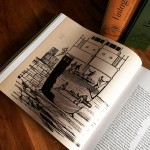 Before the new base was ready for action, each attack at Gibraltar had required a long submarine voyage, air and land transportation of the attack-teams, the shipping of supplies and weapons, arrangements for rendezvous, an approach by submarine, and finally the task of smuggling the survivors back to Italy thru neutral Spanish territory.
Before the new base was ready for action, each attack at Gibraltar had required a long submarine voyage, air and land transportation of the attack-teams, the shipping of supplies and weapons, arrangements for rendezvous, an approach by submarine, and finally the task of smuggling the survivors back to Italy thru neutral Spanish territory.
Licio Visintini’s idea became real with turning the anchored ship Olterra inside the pier of Algeciras into a secret base for SLC missions. Visintini and further technical specialists replaced the original crew of the Olterra. An assembly workshop for the SLC devices (which arrived in sections, declared as spare parts for the damaged ship) was established in the hull. A portside cabin of the Olterra became the observation post with an excellent view of Gibraltar harbour. Finally, a folding door on the port side bow (see coffee table shot of page 386-387 /chapter II.III) became the exit door for the SLC units below waterline to reach their targets – and to return back into the hull of the Olterra. After months of intensive work in total secrecy, the inconspicious ship Olterra was turned into a Trojan Horse – “il cavallo di Troia” – and six men were ready for action with their SLC devices.
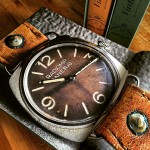 The Olterra was starting point of the following SLC missions against enemy ships in the bay of Algeciras / Gibraltar harbour: B.G.5 (7/8 December 1942), B.G.6 (7/8 May 1943) and B.G.7 (3/4 August 1943). Our book “The References” 1930’s-1940’s features two Ref. 3646 watches which were used during these missions.
The Olterra was starting point of the following SLC missions against enemy ships in the bay of Algeciras / Gibraltar harbour: B.G.5 (7/8 December 1942), B.G.6 (7/8 May 1943) and B.G.7 (3/4 August 1943). Our book “The References” 1930’s-1940’s features two Ref. 3646 watches which were used during these missions.
The Ref. 3646 / Type A “Radiomir Panerai” watch of Ernesto Notari is featured in chapter II.I (page 58-91 / see coffee table shot on the left) – more on this watch and its history can be found here. The Ref. 3646 / Type C “Radiomir Panerai” watch of Licio Visintini is featured in chapter II.III (page 350-367) – more on this watch and the history behind can be found here. The new “The References” books can be ordered only in our bookstore.
Enjoy reading!
[Ralf Ehlers & Volker Wiegmann]
Visintini’s 3646 / Type C “Radiomir Panerai”
by Volker on Oct.20, 2023, under Allgemein
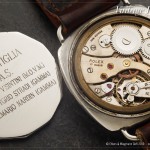 A watch of the Reference 3646 / Type C which belonged to the SLC pilot Licio Visintini is featured in chapter II.III. Visintini took part in several missions against the allied fleet in Gibraltar.
A watch of the Reference 3646 / Type C which belonged to the SLC pilot Licio Visintini is featured in chapter II.III. Visintini took part in several missions against the allied fleet in Gibraltar.
After surviving from mission B.G.3 and B.G.4 in 1941, Visintini returned undercover to Gibraltar in June 1942 where he built the core of the “Orsa Maggiore” on board the tanker Olterra – the hidden base for the SLC units of the “Decima” in the bay of Gibraltar. Mission B.G.5 turned into a “mission with no return” for Licio Visintini in December 1942…
The documentation of the watch (engraved caseback and view into the movement shown above) and the history of Licio Visintini can be read from page 350 to 397 in chapter II.III.
Information on “The References” 1930’s-1940’s (first volume) can be found here.
Inventors, pilots and a royal visitor…
by Volker on May.14, 2023, under Allgemein
The first watches for the pilots of the “new weapon” SLC were delivered in the middle of the 1930’s by Guido Panerai & Figlio to the Commando del 1° Gruppo Sommergibili of the Royal Italian Navy. According to the timeline of the development of the top secret slow running torpedos (siluro a lenta corsa, short: SLC) by the inventors Teseo Tesei and Elios Toschi, waterproof and luminous instruments for the pilots were necessary to carry out proper exercises and to control the SLC in depth and darkness.
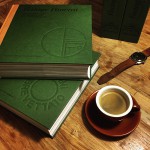 The chapters I and II, dedicated to the first watches for underwater use (Ref. 2533 and 3646) take the readers of our book “The References” 1930’s-1940’s into these early years. Teseo Tesei and Elios Toschi’s ideas became real. But strategic decisions after the Italo-Ethiopian War stopped the secret SLC project. The tests with these small weapons were archived and the Royal Italian Navy focused their interest in huge battleships, cruisers and destroyers.
The chapters I and II, dedicated to the first watches for underwater use (Ref. 2533 and 3646) take the readers of our book “The References” 1930’s-1940’s into these early years. Teseo Tesei and Elios Toschi’s ideas became real. But strategic decisions after the Italo-Ethiopian War stopped the secret SLC project. The tests with these small weapons were archived and the Royal Italian Navy focused their interest in huge battleships, cruisers and destroyers.
The SLC project was re-started by the 1st Flottiglia MAS in 1939 at the advent of the Second World War. With the first missions of the Mezzi d’Assalto carried out from August 1940 onwards, the demand for skilled operators as well as new equipment – and more instruments for the operators – grew fast. An early Ref. 3646 / Type A, dated to April 1940, is featured in chapter II.I followed by the timeline of the missions carried out by the operators of the Decima Flottiglia MAS, the special commandos of the Royal Italian Navy.
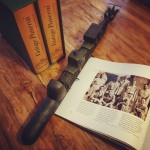 The photo shows page 96 of “The References” with a historic photo from June 1940: The two inventors of the SLC, Teseo Tesei and Elios Toschi, Alberto Franzini and Gino Birindelli above their co-pilots stand together with a royal visitor: Principe Aimone di Savoia Aosta, Duca di Spoleto – just a few weeks before the first missions of the new weapon SLC were about to write naval history.
The photo shows page 96 of “The References” with a historic photo from June 1940: The two inventors of the SLC, Teseo Tesei and Elios Toschi, Alberto Franzini and Gino Birindelli above their co-pilots stand together with a royal visitor: Principe Aimone di Savoia Aosta, Duca di Spoleto – just a few weeks before the first missions of the new weapon SLC were about to write naval history.
Read more about “The birth of a legend – the first Panerai watches (1935-1939)” in chapter I, followed by the timeline of the missions during the Second World War in chapter II.I – more information on the historic content in our “The References” book set with a total of 1392 pages can be found here. Read about the featured watches from Guido Panerai & Figlio in the first and second volume here.
A lot to read during the holiday season…
by Volker on Nov.20, 2022, under Allgemein
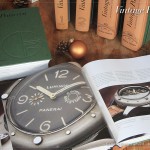 Read about watches and instruments from Guido Panerai & Figlio. Vintage Panerai watches from the 1930’s to the 1960’s are described and photographed in intricate detail for the reader, telling the stories of their first users during their dangerous underwater missions.
Read about watches and instruments from Guido Panerai & Figlio. Vintage Panerai watches from the 1930’s to the 1960’s are described and photographed in intricate detail for the reader, telling the stories of their first users during their dangerous underwater missions.
“History1” (420 pages)
“History2” (480 pages)
“The References” 1930’s-1940’s (696 pages)
“The References” 1950’s-1960’s (696 pages)
As a reference finder, as an addition to your library at home or as a special christmas gift for your friends: our Vintage Panerai books will be a great read for any Panerai collector. Each book comes with an embossed hardback jacket (leather and canvas) in a slipcase, sized 10.2 x 10.2″, trilingual (= German, Italian and English language).
Our four books are in stock and can be shipped immediately – just visit our bookstore. Use the browse by tags function to get further information about the content in each of the four books. Read how to place your order here.
Take your seat and enjoy reading!
[Ralf Ehlers & Volker Wiegmann]
Ref. 3646 / Type C “Radiomir Panerai” @ Dr. Crott
by Volker on Apr.15, 2022, under Allgemein
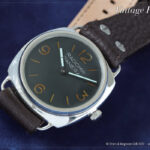 We recently added another unknown watch into our database – yet another piece of the puzzle surfaced: a Ref. 3646 / Type C with “Radiomir Panerai” sandwich dial, being watch #63 in our records of watches matching the criteria of the 3646 / Type C.
We recently added another unknown watch into our database – yet another piece of the puzzle surfaced: a Ref. 3646 / Type C with “Radiomir Panerai” sandwich dial, being watch #63 in our records of watches matching the criteria of the 3646 / Type C.
The Ref. 3646 / Type C “Radiomir Panerai” will be auctioned on 21 May 2022 at Dr. Crott’s 106th auction in Mannheim/Germany. It has been consigned by the family of the German “Kampfschwimmer” veteran Heinz Greten. Further info on auction lot 156 can be found here.
The watch appears with an unpolished case with a matching high bezel, typical for watches with “Radiomir Panerai” sandwich dial. The watch comes with a tubular shaped Rolex Oyster crown (Type 13). Inside the watch is a Rolex Cal. 618 / Type 1 movement with typical decorations and engravings on the bridges (ROLEX 17 RUBIS / FAB. SUISSE). The inner caseback bears the typical Rolex SA hallmark, reference and case number known for 3646 / Type C watches, with “Half Polish” decoration. Both hands appear black painted and re-lumed. The inner caseback bear also watchmakers’ service marks.
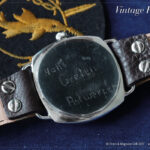 Noteworthy:
Noteworthy:
The outer caseback of the watch bear engravings of the first owner, German “Kampfschwimmer” Petty Officer Hans Greten with the additional info Antwerpen, referring to a mission he took part in September 1944.
The mission (“Operation Bruno” – the attack of the Kruisschans floodgates in Antwerp) is documented in the book “Sabotage unter Wasser” written by Michael Jung (2004) on page 120-121, as well as a photo of Hans Greten on page 107. Further info on this frogmen mission is also found in the book “Das Kommando der Kleinkampfverbände der Kriegsmarine” written by Helmut Blocksdorf (2003), on page 181. The earliest documentation of the mission is dating back to 1956 in the book “…denn sie liebten doch das Leben” written by Cajus Bekker (chapter six, page 148-160), in which Greten is mentioned several times (all books are written in German language).
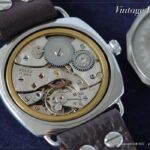 Features of the watch:
Features of the watch:
Reference: 3646 / Type C
Dial: “Radiomir Panerai” (sandwich)
Case number: 10102XX
Movement: Rolex Cal. 618 / Type 1
In our book “The References” 1930’s-1940’s the watches of the entire reference 3646 are featured in chapter II with more than six hundred pages in the chapters II.I-II.VII. The seven different variations (including the number group 3646 / Type C – page 248-397 – to which this watch belongs) can be found in our reference quickfinder on page 14-20.
Please note that the very rare campaign insignia 3rd degree (visible in the background of the second photo) is the (separate) lot 155 and is not included in the lot of the watch. Information on different probation and campaign insignia of the German “Kampfschwimmer” units can be found in our book “History2” in chapter IX.
We hope the watch will find a good new home and that it remain surfaced in the Vintage Panerai collectors world. [Ralf Ehlers & Volker Wiegmann]
A Ref. 3646 / Type E with brass dial
by Volker on Sep.12, 2021, under Allgemein
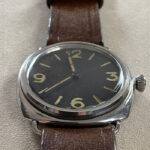 Introducing another Ref. 3646 / Type E watch which surfaced in Germany – this specimen appeared with painted brass dial.
Introducing another Ref. 3646 / Type E watch which surfaced in Germany – this specimen appeared with painted brass dial.
Noteworthy is the well preserved original strap and “Bottle Opener” buckle, wich most of today’s surfacing watches don’t have anymore.
The “Kampfschwimmer” watch with anonymous painted brass dial has an unpolished case with a matching flat bezel. The onion shaped winding crown (“BREVET +” Type 11) can be screwed down onto the collar of the 47 mm cushion shaped case with soldered lugs.
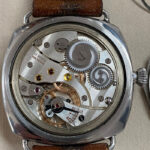 Features of the watch:
Features of the watch:
Reference: 3646 / Type E
Dial: “Kampfschwimmer” (painted brass, anonymous)
Case number: 2608XX
Movement: Rolex Cal. 618 / Type 1 mod.
Inside the watch is a Rolex Cal. 618 / Type 1 mod. movement with typical decorations and engravings on the bridges (17 RUBIS / FAB. SUISSE). The blued steel hands appear untouched with original luminous material. The inner caseback is decorated with half polish. An overview of different decorative polish on the inside of the caseback (Type A – Type G) can be found on page 486 in our book “The References” 1930’s-1940’s.
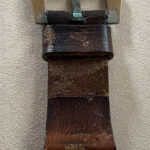 Find more info on straps and buckles here. More info on Ref. 3646 watches without Rolex hallmarks can be found here. More info on Ref. 3646 watches with brass dials can be found here.
Find more info on straps and buckles here. More info on Ref. 3646 watches without Rolex hallmarks can be found here. More info on Ref. 3646 watches with brass dials can be found here.
Here we added another unknown watch into our database – yet another piece of the puzzle surfaced. Thanks to the collector who shared the photos and information with us!
A Ref. 3646 / Type E watch surfaced in New Zealand
by Volker on Sep.07, 2021, under Allgemein
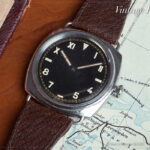 Webb’s auction house from Auckland / New Zealand contacted us recently, providing information and photos of a yet unknown Ref. 3646 / Type E with “California Dial”. The watch appears with the matching flat bezel and both lead seals above and below the 47 mm cushion shaped case. The outer caseback is not engraved and the inner caseback is missing the Rolex hallmark and reference number, which is a typical feature of Ref. 3646 / Type E watches. The onion shaped winding crown (“BREVET +” Type 11) can be screwed down onto the collar of the 47 mm cushion shaped case with soldered lugs.
Webb’s auction house from Auckland / New Zealand contacted us recently, providing information and photos of a yet unknown Ref. 3646 / Type E with “California Dial”. The watch appears with the matching flat bezel and both lead seals above and below the 47 mm cushion shaped case. The outer caseback is not engraved and the inner caseback is missing the Rolex hallmark and reference number, which is a typical feature of Ref. 3646 / Type E watches. The onion shaped winding crown (“BREVET +” Type 11) can be screwed down onto the collar of the 47 mm cushion shaped case with soldered lugs.
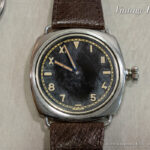 The “Error-Proof Radium Dial” by Rolex, with its railroad track minute markers and “SWISS MADE” signature at six o’clock, features half arabic and half roman numbers with luminous material applied from above.
The “Error-Proof Radium Dial” by Rolex, with its railroad track minute markers and “SWISS MADE” signature at six o’clock, features half arabic and half roman numbers with luminous material applied from above.
Since 2016, five new watches of the number group Ref. 3646 / Type E surfaced, two of them expanded the number group from 260856 – 261097 (as of 1.1.2016) to 260850 – 260111. We have 31 Ref. 3646 / Type E watches recorded as of today, including this specimen from New Zealand.
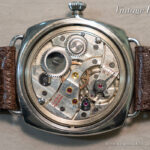 Features of the watch:
Features of the watch:
Reference: 3646 / Type E
Dial: “California Dial”
Case number: 2609XX
Movement: Rolex Cal. 618 / Type 1 mod.
You can read more about Ref. 3646 watches with dissappeared Rolex hallmarks here.
[Photos with kind permission / courtesy of www.webbs.co.nz]
Ref. 3646 / Type D with brass dial @ Dr. Crott
by Volker on Aug.26, 2021, under Watch Point
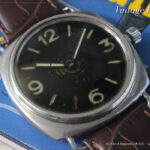 We recently added another unknown watch into our database – yet another piece of the puzzle surfaced, which marks the Ref. 3646 / Type D #104 in our records. The “Kampfschwimmer” watch with anonymous painted brass dial appears with an unpolished case with a matching flat bezel. The original winding crown has been replaced.
We recently added another unknown watch into our database – yet another piece of the puzzle surfaced, which marks the Ref. 3646 / Type D #104 in our records. The “Kampfschwimmer” watch with anonymous painted brass dial appears with an unpolished case with a matching flat bezel. The original winding crown has been replaced.
Watches of the Reference 3646 / Type D are featured in our book “The References” 1930’s-1940’s in chapter II.IV (page 398-531) including a historic photo of a “Kampfschwimmer” wearing a 3646 with brass dial on page 475. Brass dialed Ref. 3646 / Type D are featured on page 468-493. In this part of the book, an overview of different decorative polish on the inside of the caseback (Type A – Type G) can be found on page 486.
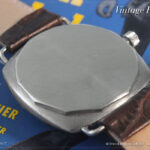 The caseback of the watch is not engraved. However, a handwritten note from the son of the “Kampfschwimmer” explains that his father completed his training in Bad Tölz at Lehrkommando 702. You can read more about the training site Bad Tölz and the Lehrkommando 702 in our book “History2” on page 660-662 and 789-795.
The caseback of the watch is not engraved. However, a handwritten note from the son of the “Kampfschwimmer” explains that his father completed his training in Bad Tölz at Lehrkommando 702. You can read more about the training site Bad Tölz and the Lehrkommando 702 in our book “History2” on page 660-662 and 789-795.
The watch will be up for auction on November 13, 2021 at Dr. Crott’s 105th auction in Mannheim.
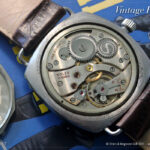 The inner caseback bears the typical Rolex SA hallmark, reference and case number known for 3646 / Type D watches. Inside the watch is a Rolex Cal. 618 / Type 1 movement with typical decorations and engravings on the bridges (ROLEX 17 RUBIS / FAB. SUISSE).
The inner caseback bears the typical Rolex SA hallmark, reference and case number known for 3646 / Type D watches. Inside the watch is a Rolex Cal. 618 / Type 1 movement with typical decorations and engravings on the bridges (ROLEX 17 RUBIS / FAB. SUISSE).
Features of the watch:
Reference: 3646 / Type D
Dial: “Kampfschwimmer” (painted brass, anonymous)
Case number: 2607XX
Movement: Rolex Cal. 618 / Type 1
We hope that this Ref. 3646 / Type D with brass dial will find a good new home and remains surfaced in the Vintage Panerai collectors world. [Ralf Ehlers & Volker Wiegmann]

